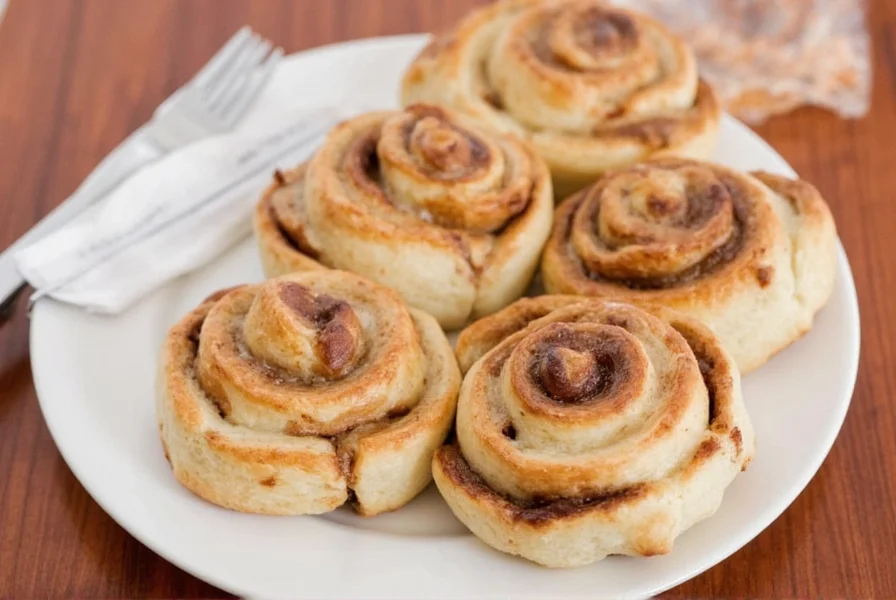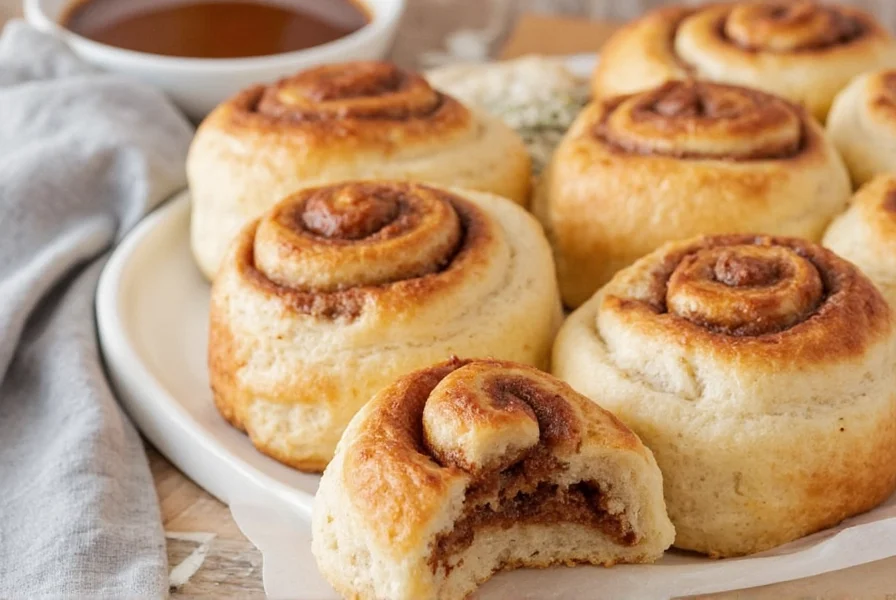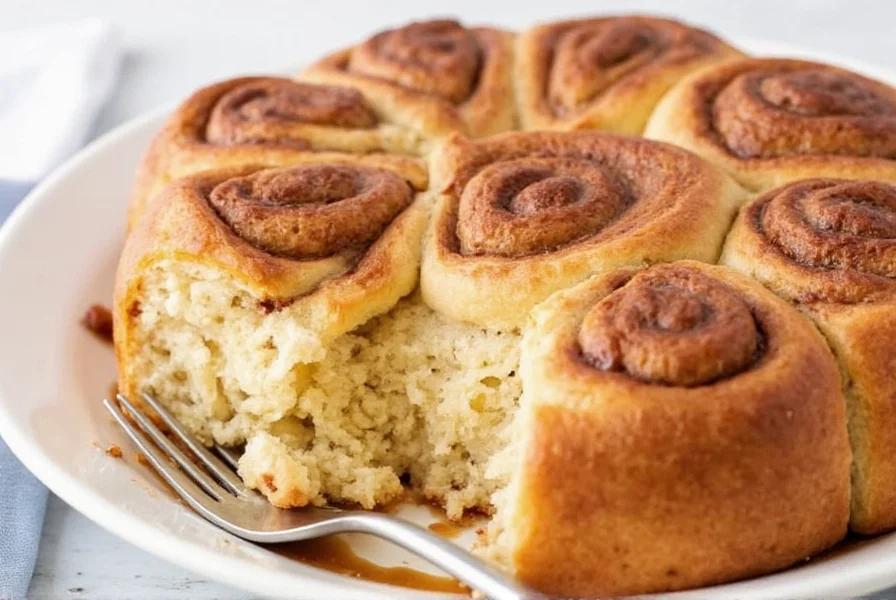Nothing says weekend breakfast quite like the aroma of freshly baked cinnamon rolls filling your kitchen. These sweet, spiral-shaped pastries have become a beloved morning tradition in households across America, offering the perfect balance of warm spices, tender dough, and creamy icing. While store-bought options exist, nothing compares to homemade breakfast cinnamon rolls made with care and quality ingredients.
The Science Behind Perfect Cinnamon Rolls
Understanding the chemistry of cinnamon roll baking transforms good rolls into exceptional ones. The magic begins with yeast activation—water temperature between 105-110°F (40-43°C) creates the ideal environment for yeast to multiply without killing it. Too hot and you'll destroy the yeast; too cold and activation will be sluggish.
Dough texture is equally crucial. Properly kneaded dough should feel smooth and slightly tacky but not stick to clean fingers. This indicates the gluten has developed sufficiently to trap air bubbles during rising, creating that signature light, fluffy texture. Over-kneading leads to tough rolls, while under-kneading results in dense pastries that won't rise properly.

Ingredient Breakdown: Why Each Component Matters
Every ingredient in breakfast cinnamon rolls serves a specific purpose beyond just flavor:
| Ingredient | Function | Pro Tip |
|---|---|---|
| Yeast | Leavening agent that creates air pockets | Always check expiration date; test in warm liquid with sugar |
| Bread flour | Higher protein content creates better structure | Substitute with all-purpose flour plus 1 tbsp vital wheat gluten |
| Butter | Adds richness and tenderizes dough | Use unsalted for better flavor control |
| Cinnamon | Primary flavor component | Ceylon cinnamon offers more complex flavor than Cassia |
| Powdered sugar | Creates smooth icing without graininess | Sift before using to prevent lumps |
Step-by-Step Recipe for Best Homemade Breakfast Cinnamon Rolls
Follow these detailed instructions for consistently perfect cinnamon rolls every time:
Dough Preparation
- Warm 1 cup milk to 110°F and dissolve 2¼ tsp active dry yeast and 2 tbsp sugar. Let sit 5-10 minutes until foamy.
- In a separate bowl, combine 4½ cups bread flour, ⅓ cup sugar, 1 tsp salt, and 1 tsp cinnamon.
- Add ½ cup softened butter and yeast mixture to dry ingredients. Mix until a shaggy dough forms.
- Knead 8-10 minutes by hand or 5-7 minutes with dough hook until smooth and elastic.
- Place in greased bowl, cover, and let rise 1-2 hours until doubled.
Filling and Shaping
- Mix 1 cup brown sugar and 3 tbsp cinnamon for filling.
- Roll risen dough into 18x12 inch rectangle on floured surface.
- Spread ½ cup softened butter evenly over dough, then sprinkle with sugar-cinnamon mixture.
- Tightly roll from long side, pinch seam to seal, and cut into 12 equal pieces.
- Place in greased 9x13 inch pan, cover, and let rise 30-45 minutes.
Baking and Icing
- Bake at 350°F for 20-25 minutes until golden brown.
- While baking, prepare icing: beat 4 oz cream cheese, ¼ cup butter, 2 cups powdered sugar, 1 tsp vanilla, and 2 tbsp milk.
- Immediately spread icing over warm rolls for perfect adhesion.

Troubleshooting Common Cinnamon Roll Problems
Even experienced bakers encounter issues. Here's how to solve the most frequent problems when making easy cinnamon roll breakfast ideas:
- Dense rolls: Usually caused by too much flour or under-proofed dough. Measure flour properly using the spoon-and-level method, and allow full rising time.
- Flat rolls: Over-proofing is the culprit. Dough should double in size but not collapse when poked.
- Runny icing: Add more powdered sugar 1 tbsp at a time until desired consistency. For make-ahead breakfast cinnamon rolls, prepare icing just before serving.
- Burnt bottoms: Place pan on a lower rack or use a double pan to distribute heat more evenly.
- Dry rolls: Overbaking or insufficient butter in the recipe. Use an oven thermometer to verify temperature accuracy.
Variations for Every Dietary Need
Adapt this classic recipe to accommodate various preferences while maintaining that perfect cinnamon roll texture:
Gluten-Free Breakfast Cinnamon Rolls
Use a quality gluten-free flour blend with xanthan gum. Increase liquid slightly as GF flours absorb more moisture. Let the dough rest 10 minutes after mixing to allow flours to hydrate fully before kneading.
Healthy Breakfast Cinnamon Roll Alternatives
For a lighter option, substitute half the butter with unsweetened applesauce, use coconut sugar instead of brown sugar, and add 1-2 tbsp ground flaxseed to the dough for extra fiber. These healthy breakfast cinnamon roll alternatives maintain flavor while reducing calories.
Make-Ahead Breakfast Cinnamon Rolls
Prepare rolls through shaping, then cover and refrigerate overnight. In the morning, remove from fridge 30 minutes before baking to take the chill off, then bake as directed. This make-ahead breakfast cinnamon rolls method saves precious morning time.
Storage and Reheating for Maximum Freshness
Proper storage maintains that just-baked quality:
- Room temperature: Store covered for up to 2 days. Place parchment between layers to prevent sticking.
- Refrigerator: Keep for 5-7 days. Reheat individual rolls in microwave for 15-20 seconds.
- Freezer: Freeze un-iced rolls for up to 3 months. Thaw overnight in refrigerator, then warm in 300°F oven for 10 minutes before adding icing.
For the best texture when reheating, place a cup of water in the microwave with your roll to create steam that revives the soft crumb. Never reheat more than needed—freshly warmed cinnamon rolls always taste superior to those that have been repeatedly reheated.
Frequently Asked Questions
How do I prevent my cinnamon rolls from becoming dry?
To prevent dry cinnamon rolls, avoid overbaking and measure flour accurately using the spoon-and-level method. Too much flour is the most common cause of dry rolls. Also, ensure your dough has proper hydration—it should be smooth and slightly tacky but not sticky. Adding a small amount of extra milk (1-2 tsp) can help maintain moisture, especially in dry climates.
Can I use instant yeast instead of active dry yeast for breakfast cinnamon rolls?
Yes, you can substitute instant yeast for active dry yeast in a 1:1 ratio. The main difference is that instant yeast can be mixed directly with dry ingredients without proofing in liquid first. If using instant yeast, you may notice slightly faster rising times. Reduce the liquid temperature to 120-130°F when using instant yeast for best results.
Why did my cinnamon roll dough not rise properly?
Dough that doesn't rise properly usually indicates issues with yeast activation. Check that your yeast is fresh (not expired), the liquid temperature was between 105-110°F (too hot kills yeast, too cold doesn't activate it), and that you included sugar to feed the yeast. Environmental factors like cold kitchen temperatures can also slow rising—try placing dough in a slightly warmed oven (turned off) with a bowl of hot water for a more consistent proofing environment.
What's the ideal consistency for cinnamon roll icing?
The perfect cinnamon roll icing should be thick enough to coat the back of a spoon but thin enough to drizzle smoothly. Start with 2 cups powdered sugar, ¼ cup softened butter, 1 tsp vanilla, and 2 tbsp milk. Add milk ½ tsp at a time if too thick, or powdered sugar 1 tbsp at a time if too thin. For make-ahead breakfast cinnamon rolls, prepare icing just before serving as it will thicken when refrigerated.
How can I make my cinnamon rolls extra fluffy?
For extra fluffy cinnamon rolls, use bread flour instead of all-purpose flour for better gluten development. Ensure proper kneading (8-10 minutes by hand) to develop the gluten structure. Allow full rising time—dough should double in size. Don't overcrowd the pan; rolls need space to expand while baking. Finally, avoid overbaking; remove rolls when they're golden but still soft to the touch.











 浙公网安备
33010002000092号
浙公网安备
33010002000092号 浙B2-20120091-4
浙B2-20120091-4